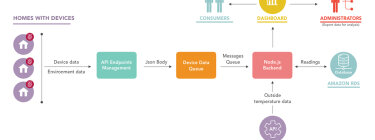How to Achieve Meaningful User Behavior from Internet of Things Implementations

We have been involved in 3 recent IoT projects:
- A company (FreshAir Sensors) that uses a plug-in device that can detect when someone is smoking. The device connects via the WiFi, and reports back detected activity. An app will notify the user when an event has been recorded. The incident data is recorded and can be used as proof by the homeowner/building manager.
- Smart building solutions (Logical Buildings) that provide real-time data and actions for building operations. Energy use data from smart meters is combined with weather and price data, and presented back to the building owners/managers via a set of tools, including a dashboard, alerts, action items.
- A study completed with a research team from a large University that involved collecting and storing smart meter, temperature and price data to be analyzed and presented to the users and administrators to see how behavior changed when cohorts were treated differently.
Careful planning ensures complete results
Our process involves spending enough time on planning and design to ensure that the experience is engaging, and ultimately makes someone’s job easier, or their life richer/more meaningful, because of this product. We take the time to explore the user journey and wireframe and design the user experience in the application, taking into account the richness of the data and the needs of the end user.
Data Interpretation
The amount of data received from a device can be overwhelming and quite often meaningless in isolation. It’s important to distill it down to something manageable, as well as couple it with other relevant data to tell a story to the user. For example, with the University study we were receiving meter data every 5 minutes. The first task was to take the data, store it and crunch it, ready to present to the user. The second was to add complementary information in the form of weather and price data. The front end design phase resulted in a story being told through screens, graphs, comparisons, around how the consumer’s usage related to the temperature outside, as well as educating them on their cost.
Engagement
Another challenge is to engage the consumer so that they will make use of tools they are provided with, act on alerts they receive, and/or keep using the product.
It’s important to make sure alerts aren’t too frequent so that the user becomes blind to them. The average US smartphone user receives 46 app push notifications per day. In order for them not to get lost in the shuffle, these alerts need to be significant and actionable. For example, with FreshAir Sensors, an alert will tell the user that someone is smoking in their property and they need to act immediately. Before, smoking fees could easily be contested by the customer and refused by the credit card companies. With FreshAir Sensors, the credit card company has accepted the proof provided.
More subtly, alerts can drive the user back to the interface, where additional functionality/tools are available. For example, with Logical Buildings an alert can tell a building manager that they are getting close to hitting high levels of usage, and they should open the application for a checklist of actions they can take to save energy. In this case the alert is significant and actionable.
In summary, launching a successful IoT product requires careful planning of the user experience, the data being processed and presented, and the tools that users will have access to, in order to ensure that interactions are meaningful and significant, leading to continued use and engagement.
